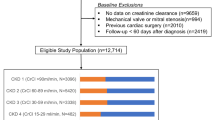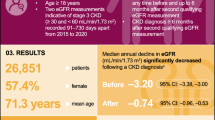Abstract
Background
Atrial fibrillation (AF) and chronic kidney disease (CKD) frequently co-exist. The frequency of kidney monitoring and range of kidney function in patients with AF in clinical practice are uncertain.
Methods
All adult Albertans with AF between 2008 and 2017 were identified using ICD-9 and -10 codes 427.3 and I48. Kidney Disease Improving Global Outcomes (KDIGO) risk categories were defined using eGFR by the Chronic Kidney Disease Epidemiology Collaborative equation and albuminuria results within 6 months of eGFR measurement. eGFR trajectories were compared from baseline to maximum value within the following year.
Results
Among 105,946 patients with AF, 16.0% were KDIGO category G1 (eGFR ≥ 90), 49.0% G2 (60–89.9), 19.8% G3a (45–59.9), 11.4% G3b (30–44.9), and G4 3.8% (15–29.9). Albuminuria was normal/mild 83.4%, moderate 11.7%, and severe 4.9%. Kidney monitoring was more common among people with lower eGFR and worse albuminuria, from approximately twice annually for G1-2/A1-2 to 8 times annually in stage G4A3. Approximately 60–80% of patients received guideline-recommended monitoring, consistent across KDIGO stages. With lower baseline eGFR, annual change in eGFR decreased while the relative proportion of patients who worsened compared to improved increased: for baseline eGFR 60–89.9, 16.7% worsened vs 6.7% improved, but for eGFR 30–44.9, 8.8% worsened but only 1.0% improved.
Conclusion
The frequency of kidney function monitoring in patients with AF increased with worsening KDIGO risk category and adhered to KDIGO guidelines in approximately three quarters of patients. A minority of patients had moderate to severe eGFR impairment, of whom most remained stable over 1 year.



Similar content being viewed by others
References
Healey JS, Oldgren J, Ezekowitz M, Zhu J, Pais P, Wang J, et al. Occurrence of death and stroke in patients in 47 countries 1 year after presenting with atrial fibrillation: a cohort study. Lancet. 2016;388(10050):1161–9.
Hawkins NM, Jhund PS, Pozzi A, O’Meara E, Solomon SD, Granger CB, et al. Severity of renal impairment in patients with heart failure and atrial fibrillation: implications for non-vitamin K antagonist oral anticoagulant dose adjustment. Eur J Heart Fail. 2016;18(9):1162–71.
Inohara T, Holmes DN, Pieper K, Blanco RG, Allen LA, Fonarow GC, et al. Decline in renal function and oral anticoagulation dose reduction among patients with atrial fibrillation. Heart. 2020;106(5):358–64.
Yao X, Shah ND, Sangaralingham LR, Gersh BJ, Noseworthy PA. Non-vitamin K antagonist oral anticoagulant dosing in patients with atrial fibrillation and renal dysfunction. J Am Coll Cardiol. 2017;69(23):2779–90.
Kidney Disease: Improving Global Outcomes (KDIGO). KDIGO 2012 clinical practice guideline for the evaluation and management of chronic kidney disease. Kidney Int Suppl. 2013;3(1):1–150.
Andrade JG, Aguilar M, Atzema C, Bell A, Cairns JA, Cheung CC, et al. The 2020 Canadian Cardiovascular Society/Canadian Heart Rhythm Society Comprehensive Guidelines for the Management of Atrial Fibrillation. Can J Cardiol. 2020;36(12):1847–948.
Hemmelgarn BR, Clement F, Manns BJ, Klarenbach S, James MT, Ravani P, et al. Overview of the Alberta Kidney Disease Network. BMC Nephrol. 2009;10:30.
Hawkins NM, Daniele PR, Humphries KH, Ezekowitz JA, McAlister FA, Sandhu RK, et al. Empirical insights when defining the population burden of atrial fibrillation and oral anticoagulation utilization using administrative data. Can J Cardiol. 2019;35(10):1412–5.
Diabetes Canada Clinical Practice Guidelines Expert Consortium, McFarlane P, Cherney D, Gilbert RE, Senior P. Chronic kidney disease in diabetes. Can J Diabetes. 2018;42 Suppl 1:S201–9.
American Diabetes Association. 10. Microvascular Complications and Foot Care. Diabetes Care. 2017;40(Suppl 1):S88–98.
Bohm M, Ezekowitz MD, Connolly SJ, Eikelboom JW, Hohnloser SH, Reilly PA, et al. Changes in renal function in patients with atrial fibrillation: an analysis from the RE-LY trial. J Am Coll Cardiol. 2015;65(23):2481–93.
Eriksen BO, Ingebretsen OC. In chronic kidney disease staging the use of the chronicity criterion affects prognosis and the rate of progression. Kidney Int. 2007;72(10):1242–8.
January CT, Wann LS, Calkins H, Chen LY, Cigarroa JE, Cleveland JC Jr, et al. 2019 AHA/ACC/HRS focused update of the 2014 AHA/ACC/HRS guideline for the management of patients with atrial fibrillation: a report of the American College of Cardiology/American Heart Association Task Force on Clinical Practice Guidelines and the Heart Rhythm Society in Collaboration With the Society of Thoracic Surgeons. Circulation. 2019;140(2):e125–51.
Steffel J, Verhamme P, Potpara TS, Albaladejo P, Antz M, Desteghe L, et al. The 2018 European Heart Rhythm Association Practical Guide on the use of non-vitamin K antagonist oral anticoagulants in patients with atrial fibrillation. Eur Heart J. 2018;39(16):1330–93.
Tonelli M, Wiebe N, Fortin M, Guthrie B, Hemmelgarn BR, James MT, et al. Methods for identifying 30 chronic conditions: application to administrative data. BMC Med Inform Decis Making. 2015;15:31.
McAlister FA, Wiebe N, Jun M, Sandhu R, James MT, McMurtry MS, et al. Are existing risk scores for nonvalvular atrial fibrillation useful for prediction or risk adjustment in patients with chronic kidney disease? Can J Cardiol. 2017;33(2):243–52.
Apostolakis S, Guo Y, Lane DA, Buller H, Lip GY. Renal function and outcomes in anticoagulated patients with non-valvular atrial fibrillation: the AMADEUS trial. Eur Heart J. 2013;34(46):3572–9.
Boriani G, Laroche C, Diemberger I, Popescu MI, Rasmussen LH, Petrescu L, et al. Glomerular filtration rate in patients with atrial fibrillation and 1-year outcomes. Sci Rep. 2016;6:30271.
Pokorney SD, Shrader P, Thomas L, Fonarow GC, Kowey PR, Singer DE, et al. Influence of kidney function estimation methods on eligibility for edoxaban population impact of the US Food and Drug Administration’s approach for its product labeling. Circulation. 2016;134(15):1122–4.
Suzuki S, Sagara K, Otsuka T, Kanou H, Matsuno S, Uejima T, et al. Estimated glomerular filtration rate and proteinuria are associated with persistent form of atrial fibrillation: analysis in Japanese patients. J Cardiol. 2013;61(1):53–7.
Kornej J, Hindricks G, Kosiuk J, Arya A, Sommer P, Husser D, et al. Renal dysfunction, stroke risk scores (CHADS2, CHA2DS2-VASc, and R2CHADS2), and the risk of thromboembolic events after catheter ablation of atrial fibrillation: the Leipzig Heart Center AF Ablation Registry. Circ Arrhythm Electrophysiol. 2013;6(5):868–74.
Roldan V, Marin F, Manzano-Fernandez S, Fernandez H, Gallego P, Valdes M, et al. Does chronic kidney disease improve the predictive value of the CHADS2 and CHA2DS2-VASc stroke stratification risk scores for atrial fibrillation? Thromb Haemost. 2013;109(5):956–60.
Banerjee A, Fauchier L, Vourc’h P, Andres CR, Taillandier S, Halimi JM, et al. A prospective study of estimated glomerular filtration rate and outcomes in patients with atrial fibrillation: the Loire Valley Atrial Fibrillation Project. Chest. 2014;145(6):1370–82.
Bonde AN, Lip GY, Kamper AL, Fosbol EL, Staerk L, Carlson N, et al. Renal function and the risk of stroke and bleeding in patients with atrial fibrillation: an observational cohort study. Stroke. 2016;47(11):2707–13.
Go AS, Fang MC, Udaltsova N, Chang Y, Pomernacki NK, Borowsky L, et al. Impact of proteinuria and glomerular filtration rate on risk of thromboembolism in atrial fibrillation: the anticoagulation and risk factors in atrial fibrillation (ATRIA) study. Circulation. 2009;119(10):1363–9.
McManus DD, Corteville DC, Shlipak MG, Whooley MA, Ix JH. Relation of kidney function and albuminuria with atrial fibrillation (from the Heart and Soul Study). Am J Cardiol. 2009;104(11):1551–5.
Roldan V, Marin F, Fernandez H, Manzano-Fernandez S, Gallego P, Valdes M, et al. Renal impairment in a “real-life” cohort of anticoagulated patients with atrial fibrillation (implications for thromboembolism and bleeding). Am J Cardiol. 2013;111(8):1159–64.
Brendorp B, Pedersen O, Torp-Pedersen C, Sahebzadah N, Kober L. A benefit-risk assessment of class III antiarrhythmic agents. Drug Saf. 2002;25(12):847–65.
Rathore SS, Curtis JP, Wang Y, Bristow MR, Krumholz HM. Association of serum digoxin concentration and outcomes in patients with heart failure. JAMA. 2003;289(7):871–8.
Alexandrou ME, Papagianni A, Tsapas A, Loutradis C, Boutou A, Piperidou A, et al. Effects of mineralocorticoid receptor antagonists in proteinuric kidney disease: a systematic review and meta-analysis of randomized controlled trials. J Hypertens. 2019;37(12):2307–24.
Wu D, Mansoor G, Kempf C, Schwalm MS, Chin J. Renal function, attributes and coagulation treatment in atrial fibrillation (R-FACT Study): retrospective, observational, longitudinal cohort study of renal function and antithrombotic treatment patterns in atrial fibrillation patients with documented eGFR in real-world clinical practices in Germany. Int J Clin Pract. 2014;68(6):714–24.
Yao RJR, Andrade JG, Deyell MW, Jackson H, McAlister FA, Hawkins NM. Sensitivity, specificity, positive and negative predictive values of identifying atrial fibrillation using administrative data: a systematic review and meta-analysis. Clin Epidemiol. 2019;11:753–67.
Disclaimer
This study is based in part by data provided by Alberta Health and Alberta Health Services. The interpretation and conclusions contained herein are those of the researchers and do not represent the views of the Government of Alberta or Alberta Health Services. Neither the Government of Alberta nor Alberta Health or Alberta Health Services express any opinion in relation to this study.
Funding
This work was funded by the Heart and Stroke Foundation, Project Number: F16-03786. Dr. Hawkins receives salary support from Vancouver Coastal Health Research Institute (F17-05424), and is the UBC Dr. Charles Kerr Distinguished Scholar in Heart Rhythm Management. Dr. McAlister holds the University of Alberta Chair in Cardiovascular Outcomes Research. Dr. Kaul holds a CIHR Sex and Gender Science Chair and the Heart and Stroke Chair in Cardiovascular Research. None of these organizations were involved in the design and conduct of the study; collection, management, analysis, and interpretation of the data; preparation, review, or approval of the article; and decision to submit the article for publication.
Author information
Authors and Affiliations
Corresponding author
Ethics declarations
Conflict of interest
All the authors have declared no competing interest.
Ethical approval
All procedures performed in studies involving human participants were in accordance with the ethical standards of the institutional and/or national research committee at which the studies were conducted (IRB approval number Pro00053469) and with the 1964 Helsinki declaration and its later amendments or comparable ethical standards.
Additional information
Publisher's Note
Springer Nature remains neutral with regard to jurisdictional claims in published maps and institutional affiliations.
Supplementary Information
Below is the link to the electronic supplementary material.
About this article
Cite this article
Hawkins, N.M., Wiebe, N., Andrade, J.G. et al. Kidney function monitoring and trajectories in patients with atrial fibrillation. Clin Exp Nephrol 27, 981–989 (2023). https://doi.org/10.1007/s10157-023-02389-z
Received:
Accepted:
Published:
Issue Date:
DOI: https://doi.org/10.1007/s10157-023-02389-z




